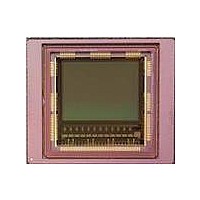CYIL2SM1300AA-GZDC Cypress Semiconductor Corp, CYIL2SM1300AA-GZDC Datasheet - Page 23

CYIL2SM1300AA-GZDC
Manufacturer Part Number
CYIL2SM1300AA-GZDC
Description
IMAGE SENSOR CMOS LUPA-1300-3
Manufacturer
Cypress Semiconductor Corp
Type
CMOS Imagingr
Specifications of CYIL2SM1300AA-GZDC
Package / Case
168-PGA
Pixel Size
14µm x 14µm
Active Pixel Array
1280H x 1024V
Frames Per Second
500
Voltage - Supply
2.5V, 3.3V
Operating Supply Voltage
2.5 V
Maximum Power Dissipation
1350 mW
Maximum Operating Temperature
+ 70 C
Supply Current
80 mA
Minimum Operating Temperature
0 C
Package
168CuPGA
Image Size
1280x1024 Pixels
Color Sensing
Monochrome
Operating Temperature
0 to 70 °C
Lead Free Status / RoHS Status
Lead free / RoHS Compliant
Lead Free Status / RoHS Status
Lead free / RoHS Compliant, Lead free / RoHS Compliant
Master Mode
In this mode, a rising edge on int_time1 pin is used to trigger the
start of integration and read out. The tint_timer defines the
integration time independent of the assertion of the input pin
int_time1. After the integration time counter runs out, the FOT
automatically starts and the image readout is done. During
readout, the image array is kept in reset. A request for a new
frame is started again when a new rising edge on int_time is
detected. The time of the falling edge is not important in this
mode.
Non Destructive Readout (NDR)
The sensor can also be read out in a nondestructive method. After a pixel is initially reset, it can be read multiple times, without being
reset. You can record the initial reset level and all intermediate signals. High light levels saturate the pixels quickly, but a useful signal
is obtained from the early samples. For low light levels, the later or latest samples must be used. Essentially, an active pixel array is
read multiple times, and reset only once. The external system intelligence interprets the data.
advantages and disadvantages of nondestructive readout.
Table 14. Advantages and Disadvantages of Non Destructive Readout
Note that the amount of samples taken with one initial reset is
programmable
nr_of_ndr_steps is one, the sensor operates in the default
method, that is one reset and one sample. This is called the
disable nondestructive read out mode.
Document Number: 001-24599 Rev. *F
Low noise, because it is true CDS
High sensitivity. The conversion capacitance is kept low.
High dynamic range. The results include signals for short and
long integration times.
in
the
Advantages
nr_of_ndr_steps
Figure 17. Principle of Non Destructive Readout
register.
System memory required to record the reset level and the
intermediate samples
Requires multiples readings of each pixel, so there is higher data
throughput
Requires system level digital calculations
If
Slave Mode
Integration time control is identical to the pipelined shutter slave
mode. The int_time1 pin controls the start of integration. When
int_time is deasserted, the FOT starts (analog value on the pixel
diode is transferred to the pixel memory element). Only at that
time, image read out can start (similar to the pipelined read out).
During read out, the image array is kept in reset. A request for a
new frame is started when int_time goes high again.
When nr_of_ndr_steps is two, there is one reset and two
samples, and so on. In the slave mode, nothing changes on the
protocol of the signals int_time_*. The sequencer suppresses
the internal reset signal to the pixel array.
Disadvantages
Table 14
time
CYIL2SM1300AA
on page 23 summarizes the
Page 23 of 43
[+] Feedback










